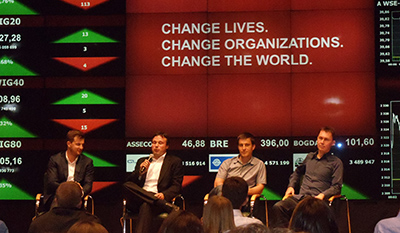This is the second of three posts in our Myth Busters series. Last week we kicked it off by upending misconceptions around interviews and campus visits. This time, we're focusing on Letters of Reference. For all the facts, we highly recommend visiting the Application Materials section of our website.
MYTH 1: If I work in a family business, am self-employed, or can't tell my boss that I'm applying, I will be at a disadvantage since I cannot get a recommendation from a current direct supervisor.
THE TRUTH: Rest assured that you are not the only applicant in this situation. You may not be disclosing to your employer that you are applying to business school. You may have started a new job recently, and your supervisor does not really know you that well. Perhaps you are self-employed, run your own company, or work in a family business where your direct supervisor is a relative (not a good choice for a recommendation!). If you're in one of these situations, you just need to be a little more creative in terms of where you get your recommendation. You could ask anyone who is in a position to evaluate your work: a previous supervisor, a client, or a member of your board of directors.
MYTH 2: It is okay to submit more than three recommendations. In fact, more is better!
THE TRUTH: We discourage you from sending additional letters. More is not better. In fact, it can have the opposite of the intended effect as it adds an additional burden to our staff who review literally thousands and thousands of pages over the application season. When we receive additional letters of reference either before or after the application deadline, we do add them to your application file, but there's no guarantee that they will be reviewed.
MYTH 3: It is better to get my recommendations from three different sources to highlight different aspects of my professional and personal background.
THE TRUTH: It's your decision how to present yourself in your application, what to highlight and what to focus on. And, this goes for your choice of recommenders as well. Some applicants get all their references from work; others choose a peer reference from outside of work. Some get all their references from their current employers; others include recent previous employers. There is no one right way. When choosing a recommender, our best advice is to (1) choose someone who knows you really well and can provide the detail, examples, and specifics that support his/her assertions; and (2) choose someone who is truly enthused to write a recommendation for you and will spend sufficient time writing a thoughtful letter.
MYTH 4: Recommendations must be written in English.
THE TRUTH: Recommendations must be submitted in English, but we do not expect the English to be perfect in recommendations written by non-native speakers. We focus on the content of the letter, not the writing style, so we will ignore syntax or grammar errors or awkward phrasing. However, if you and your recommenders think that their English is not sufficient to convey complex ideas, it may be to your advantage to have them write in their native language and then get it translated into English either by a friend or colleague of the recommender, or from a paid service. The translation does not need to be from a paid service unless that is the only option available to the recommender. The translation is the responsibility of the recommender; the translator cannot be the applicant or a friend or family member of the applicant. Your recommender would then upload both the original language and the English translation into the recommendation form, and must also supply us with the name and contact information of the translator in case we have additional follow-up questions.
MYTH 5: It's OK to provide a letter of recommendation from a professor as long as I did really well in the class.
THE TRUTH: We love professors - we are a school, after all - but faculty members typically are not the best choices for MBA recommendations. We find that they often ignore the questions we ask of recommenders, and instead, focus on how well you did in their classes (which we already know from your academic transcripts). If you are applying as a college senior and do not have much professional experience, there may be cases when a recommendation from a faculty member would be appropriate. For example, if you worked with a faculty member outside the classroom, perhaps as a teaching assistant or on an independent research opportunity, then that professor might be in a position to write a helpful recommendation. Still, you need to think carefully about whether that person can address the questions we ask in the recommendation form.
Thanks for reading! Check back next week for even more myth busting, or visit our website for myth-free admission process details.


 Professor Feigenbaum with MS in Environment and Resources/MBA students.
Professor Feigenbaum with MS in Environment and Resources/MBA students.



